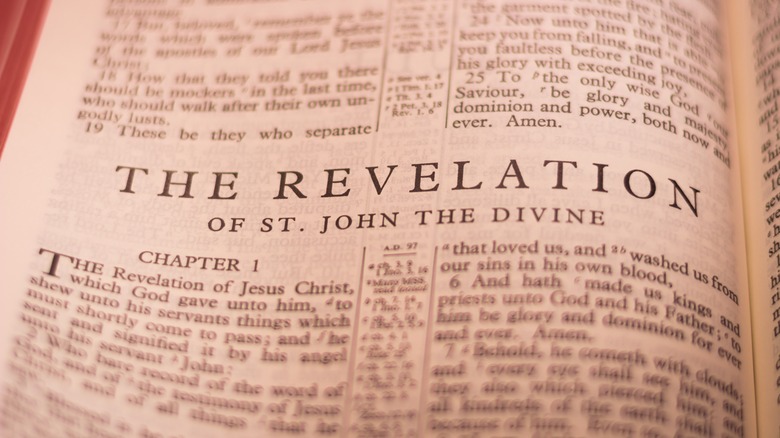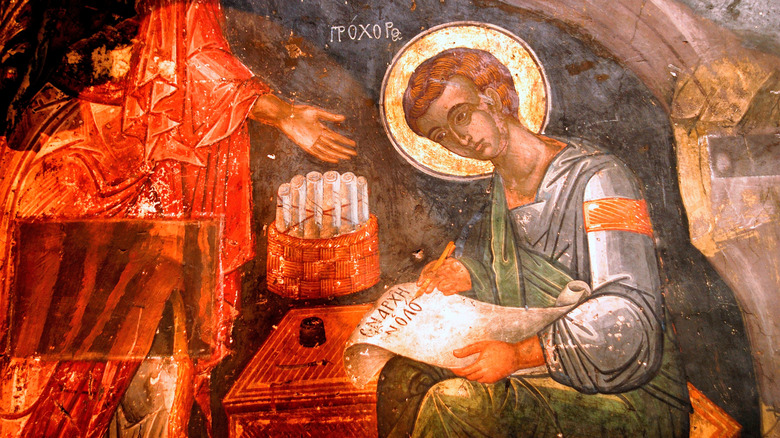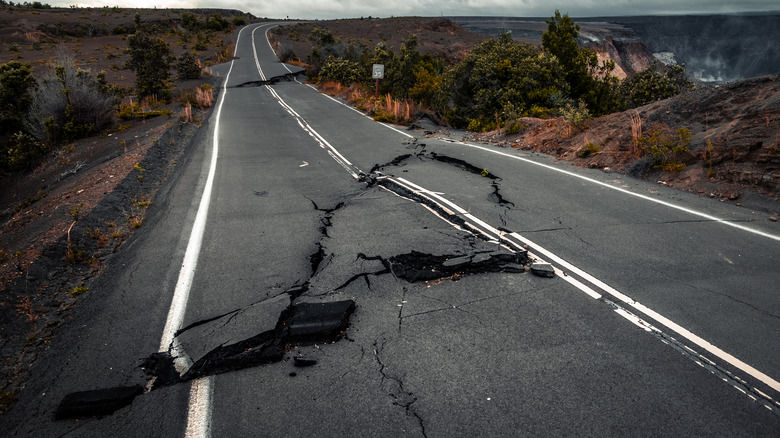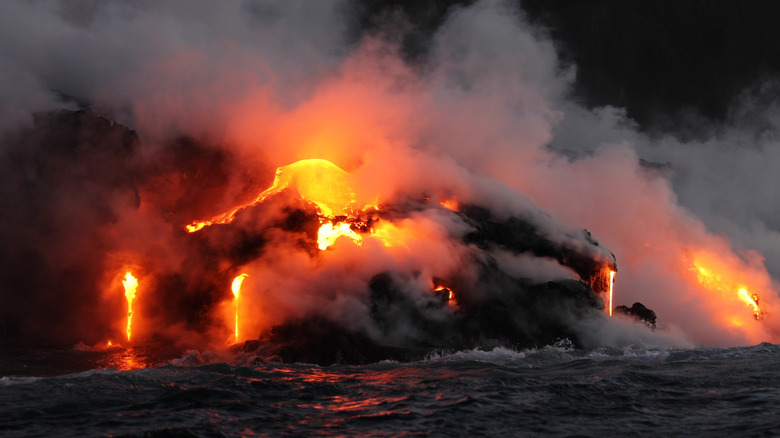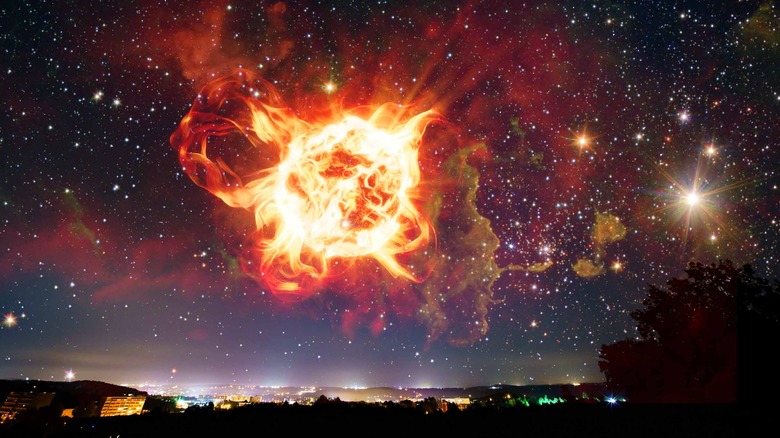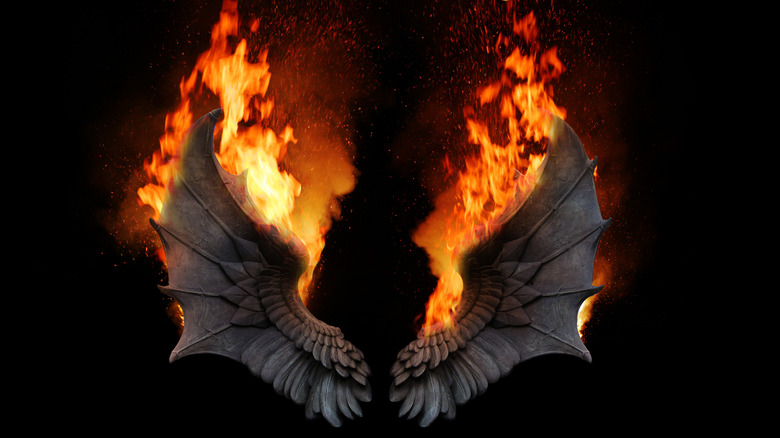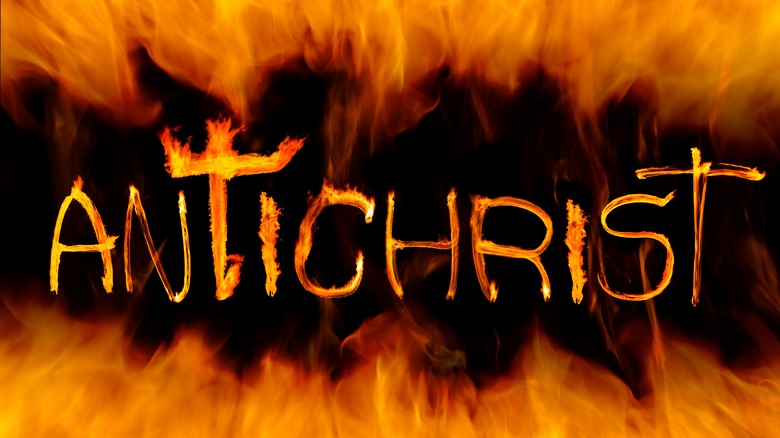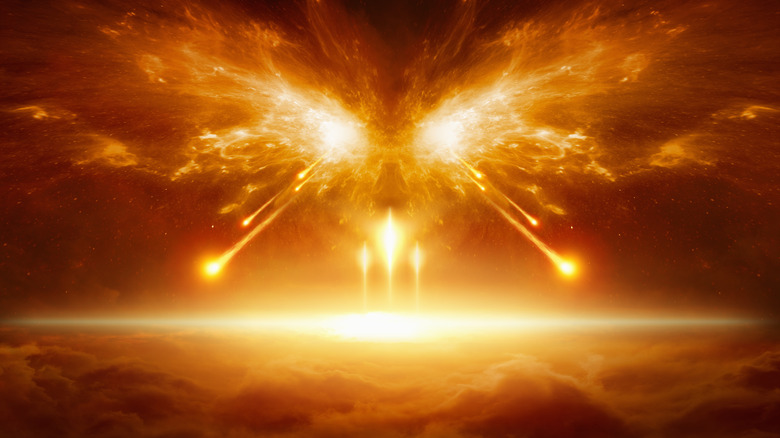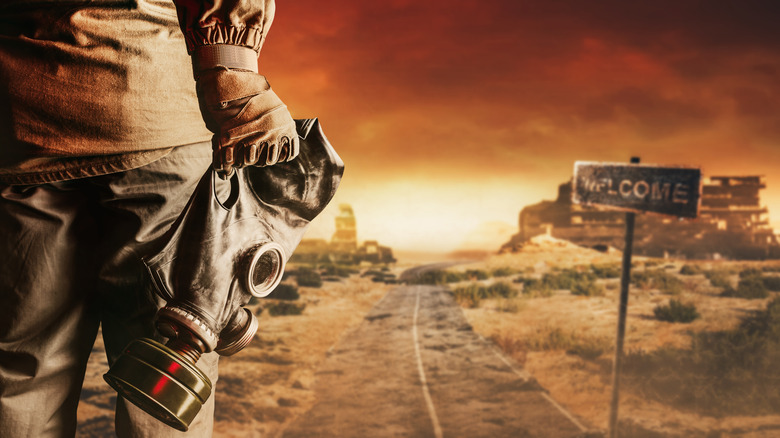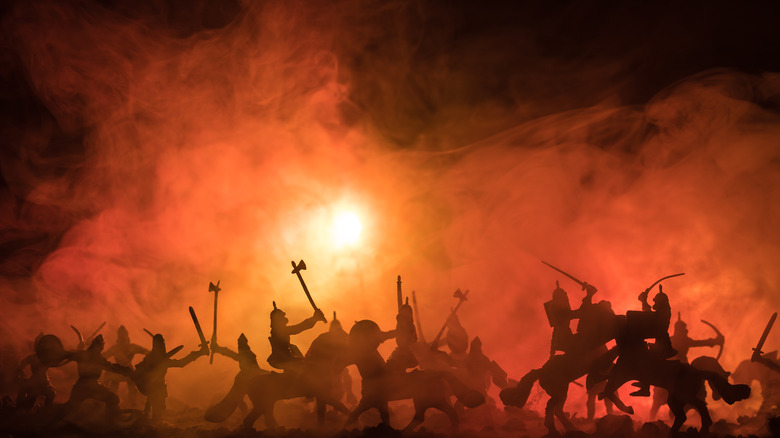Terrifying Things Described In The Book Of Revelation
From strange beasts to ominous horse riders, singing angels to bloody Armageddon, the finale of the Christian Bible — the Book of Revelation — might remind you of Johnny Cash's song "When the Man Comes Around" (via Issuu). If this isn't evocative enough, Cash isn't alone when it comes to borrowing images from the last book of the New Testament: Think Iron Maiden's "The Number of the Beast" and Metallica's "The Four Horsemen," and that's just for starters.
Musicians aren't the only artists inspired by the Book of Revelation (via Patheos). Individuals as diverse as Julia Ward Howe, Michelangelo, and John Milton have also borrowed from its trippy and terrifying imagery. That's quite a legacy for a humble ancient Mediterranean author who went simply by John, name-dropping himself three times in the first chapter of Revelation, and with a humble reminder in Revelation 22:8. The traditional view holds this to be John the Apostle of Jesus and son of Zebedee, referenced in spots like Matthew 10:2. However, some later scholars argued the author was a mysterious figure named John the Presbyter, per Oxford Reference.
The John debate aside, one thing's for sure: Whoever wrote this had some horrific visions kicking around in their head. Here's everything you need to know about the scariest book of the Bible and some of the terrifying things it contains.
God's judgment begins with seven seals
The Book of Revelation starts the countdown to the apocalypse with Jesus appearing in a vision to the author, John, according to Letter Pile, and the latter is commanded to write letters to seven churches. This innocuous start is the beginning of a pattern of sevens found throughout Revelation — a significant number in Christianity, which symbolizes perfection or completion (via Christianity and Life Hope & Truth).
By Chapter 6, seven seals of judgment get introduced, and the breaking of the first four ushers in the so-called "Four Horsemen of the Apocalypse." The first crowned equestrian rides a white horse and carries a bow, believed by some scholars to represent the Antichrist, per Crosswalk. The second rider, mounted on a red steed, brings war and violence. The third seal conjures a black horse whose rider carries balances and symbolizes famine, according to Britannica. The fourth seal unleashes the iconic image of the rider on the pale horse (a.k.a. Death), who John ominously tells us is followed closely by Hell itself.
Breaking the fifth seal shows those martyred for God, Revelation 6:9-10, who cry out for vengeance and are instructed to wait a little longer. Soon enough, the following two seals bring more devastation, as all the worst things that could possibly happen line up to terrorize the planet's inhabitants.
A gigantic earthquake reconfigures the world's land masses
The breaking of the sixth seal unleashes the earthquake to end all earthquakes, shaking the planet so much that, according to Revelation 6:12, entire continents are relocated. This massive tremor is accompanied by more than aftershocks. We're told that the "sun became black as sackcloth of hair, and the moon became as blood." Ruining the day further for cartographers and astronomers alike, more chilling events are unveiled in Revelation 6:14, where the very heavens are whisked away like a scroll getting rolled up.
But the horrors don't end there. Next, Revelation describes stars showering down from outer space, reminiscent of the devastating modern weaponry many have seen used in humanity's more recent conflicts. For example, thermite weapons were allegedly used by Russian forces in July 2022, during a nighttime assault on Donetsk, Ukraine, as reported by The Eurasian Times. These could provide a fitting visual of the stellar bombardment that the author of Revelation, John, was attempting to foretell.
Naturally, anybody still alive runs for the hills looking for places to hide in what John calls "dens." Whether these are caves, bunkers, or something else, the text doesn't make clear. But John says the people in the dens beg for the rocks and mountains to "fall on us, and hide us from the face of him that sitteth on the throne, and from the wrath of the Lamb" (Revelation 6:16). In other words, people would rather get smooshed by an avalanche than face God's judgment, per Bible Ref.
An unholy rain and a burning mountain
In Chapter Eight of Revelation, the disasters come with a musical score, with the arrival of angels sounding trumpets on seven momentous occasions. According to Christianity, these are akin to the ten plagues that befell the Egyptians in the Bible's Old Testament (via Exodus 7 through 11), such as locusts, scorpions, and rivers of blood. This time, however, it's not just confined to ancient Egypt — the entire planet is invited. Life Hope & Truth notes that the first six trumpets usher in a perfect storm of ecological disasters, and the first two don't pull any punches.
In Revelation 8:7, the first angel sounds his trumpet, and a horrific rain of fire, hail, and blood showers the Earth. This nightmarish precipitation takes out 30 percent of the Earth's forests and the entirety of its grasslands with fire. For perspective, forests cover 30 percent of the entire Earth's surface, according to the Earth Observatory, and grassland covers between 20 and 40 percent of the rest (via National Geographic).
The second trumpet introduces a "mountain burning" that collapses into the ocean, per Revelation 8:8. Some have speculated this description speaks of nuclear devastation or a comet impact (via Bible Ref). Either way, the destruction proves horrific from an ecological perspective: Thirty percent of all marine life is wiped out. Transformed into bodies of death instead of water, a third of the oceans become blood. And it's bad news for anyone hoping to ride it out on a boat — a full third of those also get swept away in the grotesque cataclysm, as reported in Revelation 8:9.
Astronomical problems and killer locusts
As Revelation continues with trumpeted disasters, entire stars start becoming dislodged and fall to Earth, including one called "wormwood," per Christianity. This fallen star contaminates one-third of all freshwater (via Revelation 8:11) and those who drink it get sick and die, per Life Hope & Truth. Then, with the sounding of another trumpet, one-third of the sun, moon, and stars vanish from the sky, messing up the cycle of days and nights (via Revelation 8:12). Chapter Eight ends with an angel ominously streaking across the sky, warning of the next three judgments.
In Chapter 9, with a fifth blast of trumpets, another star falls from the sky, this time bringing a plague of voracious locusts that devour everything. Revelation 9:6 tells us the victims of the locusts experience such agony that they beg for death. This is not surprising considering their ferocious description: They are said to have human faces, long hair, and lion's teeth. In addition, these locusts also wear iron armor and have wings that sound like racing chariots when they flap. But that's not all: they are supposed to have tails like scorpions with stingers that dole out five months of uninterrupted pain.
A pregnant woman escapes a red dragon
Chapter 12 of the Book of Revelation introduces another iconic symbol of the end times, a pregnant lady who appears in the sky crowned with a dozen stars, clothed with the light of the sun, and standing atop the moon. John describes the woman as suffering from labor contractions. But she's not headed to the hospital to give birth. Instead, she's in a fight to survive against one of the most powerful monsters of the Book of Revelation.
As described in Revelation 12:3, the lady faces a vicious scarlet dragon wearing seven crowns and bearing ten horns atop his misshapen head. The dragon waits hungrily for the woman to give birth, licking his lips in anticipation of a newborn infant meal. But at the final push, Revelation says God catches the baby, delivering it up to heaven rather than the open dragon's mouth. As for the woman, she escapes into the wilderness, where the book says she is sustained by God.
In Revelation 12:9, we learn the dragon is the devil, and, now confined to the Earth, continues to harass the woman, even attempting to kill her with a flood. Not satisfied, he turns his attention to her children — every mother's worst nightmare.
Terrifying beasts abound
The Book of Revelation is jam-packed with nightmarish beasts, like the human-faced, scorpion-tailed locusts who dispense pain in Chapter 9. But possibly one of the most terrifying of these is found in Chapter 13, emerging from the sea, as the author describes, "And I stood upon the sand of the sea, and saw a beast rise up out of the sea, having seven heads and ten horns, and upon his horns ten crowns, and upon his heads the name of blasphemy" (via Revelation 13:1).
John says the beast has what looks like a leopard's body, a mouth like a lion, and feet reminiscent of a bear. As with the locusts, the author does all sorts of juxtaposing to create an unforgettable visual, and it's a bewildering one, to say the least. Besides this strange mishmash of attributes, he is also said to wear "the name of blasphemy" on his various heads, making for a stunningly evil sight.
According to Crosswalk, this weird being is supposed to be the Antichrist, and he's put into service by Satan, the dragon. Besides the hideous appearance, the beast wields unmatched power ... the kind of power that the author tells us makes humans quake in his presence. Feeling totally unable to oppose the beast and dragon, humans resort to worshipping him and his master, the nasty, baby-eating dragon, per Revelation 13:4.
Punishments target the wicked
In Chapter 16 of Revelation, the first of several vials, the contents of which are not specified, are poured out onto the Earth. But their effects are described in excruciating detail. For starters, those on the receiving end of God's wrath find themselves covered in painful oozing sores. This is said to be a punishment for those who have taken "The mark of the beast," which Revelation refers to in the context of a one-world monetary system requiring participants to take a mark on their right hand or forehead, per Bible Ref.
While Revelation does not say so explicitly, the pain associated with these skin sores would not be unfamiliar to contemporary pre-modern readers of the book, which was written well before modern medicine (per Britannica). If these lesions are meant to be anything like boils or carbuncles as we know them now, then the utter misery is undeniable. As such sores swell with pus and dead skin cells, and the pain skyrockets, per the University of Texas at Austin.
Two more vials then pour out poison into the planet's oceans and freshwater systems. The author, John, narrates the total obliteration of aquatic life and ecologies. He describes the oceans as the consistency of a dead man's blood, implying stagnation, coagulation, and putrefaction, per Rutwik Shedge et al.'s "Postmortem Changes," and rivers, streams, and lakes share the same fate.
From deadly sun bursts to Armageddon
While solar flares pack a punch and are quite common, they have no physical impact on Earth's inhabitants thanks to the insulation provided by the atmosphere, per Earth Sky. But Chapter 16 of Revelation describes an unparalleled heatwave (via Revelation 16:8). An angel pours a vial over the sun, turbocharging it and causing a scorching of the Earth, which burns the unrepentant with a sensation "like fire."
Once the purge of the Earth by the sun occurs, Revelation swaps things up dramatically. Inky darkness replaces blasts of scorching light worldwide, as stated in Revelation 16:10. Between the boils, blood, sun flares, and darkness, those left on the planet face excruciating circumstances. John provides the following brutal description: "And they gnawed their tongues for pain."
Putting recent droughts to shame, Revelation also describes the total evaporation of the Euphrates River, located in the modern Middle East (per Britannica). John explains this makes way for world leaders from the east to ready themselves for warfare. This isn't any old battle, however, but the very Battle of Armageddon itself. According to Bible.org, some scholars translate this famous geographic label as "Mount of Slaughter," and it refers to an epic battle (or culmination of multiple battles) that outdo anything that World War I or World War II ever threw the Earth's way.
Things go Mad Max
The natural disasters described in Revelation tend to grossly outclass those experienced throughout history, and in Chapter 16, they all happen at once. They include a crazy storm with thunder and lightning, accompanied by disembodied voices audible in the heavens. This nightmarish storm is followed by an earthquake without precedent. John notes, "There was a great earthquake, such as was not since men were upon the earth, so mighty an earthquake, and so great."
This unparalleled seismic event causes whole civilizations to collapse like Lincoln Logs or Jenga sets, leaving no safe havens for terrestrial beings. But the tremors do much more than take down the globe's metropolises. John writes that it's as if the mountains and islands of Earth disappear, leaving the planet's geology unrecognizable.
Following the landscape upheaval, massive hail stones smash into the planet, pockmarking it. According to Revelation 16:21, the weight of each of these is more or less a talent, which translates in modern speak as between 75 and 100-pound projectiles, as reported by Learn Religions — well beyond the world's heaviest recorded hailstone, which weighed a comparatively puny 2.25lbs (via Arizona State University).
The mother of harlots arrives in style
Revelation 17 introduces us to one of its most recognizable and vivid characters, the "Mother of Harlots," depicted in apocalyptic imagery such as those by Albrecht Dürer (via The Met). The book's author, John, describes her as wearing red and violet clothing, decked out with every manner of precious jewel and pearl imaginable. Although an opulent vision, John makes it clear that there's nothing to admire about this woman.
Drunk on the blood of saints and martyrs, she is pictured riding around on a red dragon with ten horns and seven heads, carrying a cup of filth. And if this wasn't enough to shock the reader, the passage describes her job title as being written on her forehead as "Mystery, Babylon the Great, the Mother of Harlots and Abominations of the Earth" (via Revelation 17:5).
It is also noted in the chapter that this character sits on many "waters" (via Bible Ref), and these supposedly represent the people of the planet. As it happens, the dragon she rides on ends her appearance, turning on this "Babylon the Great" and destroying her with fire.
Mass carnage at Armageddon
Many of the greatest disaster tales have a bloody and hard-fought climax, and The Book of Revelation does not disappoint. After the world has been ravaged, again and again, the fever-dream tale of woe reaches a crescendo with the armies of the world assembling at Armageddon for a world-ending battle (via Revelation 19:15). The Earth's leaders, led by the Antichrist, attempt to make war on God and his followers, who have descended from heaven riding horses, according to Britannica, and are led by Jesus himself. However, this isn't the gentle Jesus of the Gospels. Instead, he's a fearsome warrior who "treadeth the winepress of the fierceness and wrath of Almighty God," carrying a sword, his eyes spouting flames, and rocking a tattoo on his thigh. And he's not in a forgiving mood, either.
As the battle progresses and the body count rises, an angel calls out to the birds of the earth to come feast on the flesh of those falling in battle, per Revelation 19:18. The head bad guys (including the beasts) are rounded up and thrown into a massive pit filled with brimstone and fire, while Jesus mops up the rest with his sword.
Revelation isn't quite done with the carnage, though, even after God's army claims victory. As Chapter 20 relates, Satan is only sent for a time-out, albeit a thousand-year one, after which it says he "must be loosed a little season." All the while, an eternity in a lake of fire awaits those who would be judged poorly at the end of this hiatus.
